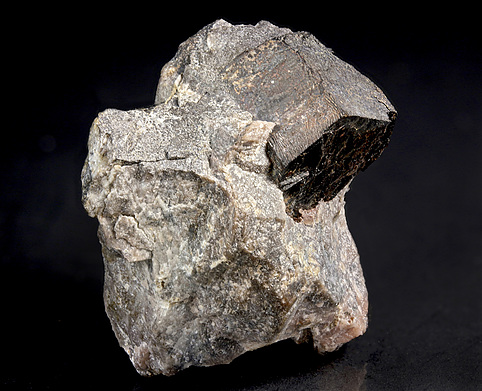Ferrokinoshitalite : (Ba,K)(Fe2+,Mg)3(Al2Si2O10)(OH,F)2

Photo added to mindat.org
“Ferrokinoshitalite and “chloroferrokinoshitalite” were recently (Jan 2019) added to the species list for the Franklin Mining District on the basis of detailed chemical analyses by Tracy (1991) for Ba-rich micas from Sterling Hill. (See the Sterling Mine publication list.) Van King has now interpreted these analyses in terms of current mica terminology and has found that one of them corresponds to ferrokinoshitalite and three to “chloroferrokinoshitalite”. The latter has never been published. Tracy and Dunn (1995) referred to these as “anomalous anandite”. See the Mindat description of “chloroferrokinoshitalite” for details.
More recently, EDS analysis of material found on the Buckwheat Dump in 1995 and/or 1996, and pictured here, has identified another occurrence of likely ferrokonoshitalite in the District. Like the Sterling Hill material, this is not end-member ferrokinoshitalite but probably has a hendricksite component. See the analysis “photo” further discussion. Note that while the material was found on the Buckwheat Dump, it is not typical of the material found there. In fact, it was found in a wooded/brushy area on one edge of the Dump. Several other unusual minerals were also found here. But many of these, including the ferrokinoshitalite, have substantial amounts of Zn, so there is little doubt that this is “Franklin” material. Note added Fed 2023: I have just noticed that some of the matrix fluoresces bright orange-red under SW UV and magenta-red inder MW UV. So it is fairly typical "Franklin" calcite even though it is relatively fine-grained and dark. At the time these photos were posted, I didn't have any functional UV sources, so the fluorescence was not observed.
The main crystal in the photos is about 1 cm tall and 1.5 cm in greatest diameter. The matrix is mostly a “fast-fizzy” gray to pink carbonate (presumably calcite), but some “slow-fizzy” grains and a bit of insoluble residue were observed. Included in some smaller, broken, crystals of ferrokinoshitalite are small, nearly colorless crystals of fairly euhedral “apatite”. Note added Feb 2023: The apatite fluoresces fairly bright pinkish. This is an usual response for "Franklin". I will post iamges as time permits.
”
Modris Baum - 3rd January 2019

Photo added to mindat.org
“The ideal formula for ferrokinoshitalite is (Ba,K)(Fe2+,Mg)3(Al2Si2O10)(OH,F)2. The empirical formula for type locality material presented in [http://rruff.info/rruff_1.0/uploads/CM37_1445.pdf] is (Ba0.47,K0.33,Na0.04)(Fe2+1.72,Mg0.74,Mn0.08,Fe3+ 0.15,Ti0.17)(Si2.44,Al1.56)O10(OH1.35, F0.65)
As noted under the parent photo, both the material from Sterling Mine and this sample from the Buckwheat Dump have substantial Zn. They also have substantial Cl, although the amount in the Buckwheat material is less than at Sterling Hill. If the Zn is interpreted as a hendrickite “component”, I estimate that the Sterling Hill ferrokinoshitalite is about 1/9th hendricksite and that the Buckwheat material is (very roughly) about 1/3 hendricksite.
The ideal formula for hendricksite is K(Zn,Mg,Mn2+)3(AlSi3O10)(OH)2, so based on the near equality of the peak heights of K and Ba in the scan for the Buckwheat material, one might guess that the material is really borderline ferrokinoshitalite-hendricksite. However, based on scans for other minerals, it appears that Ba is somewhat less readily detected than K with the equipment used. So probably Ba is actually > K.
A better way to look at this may be the following:
According to [http://www.handbookofmineralogy.com/pdfs/hendricksite.pdf], two probes of Franklin hendricksite both produced empirical formulae with K ~= Mn and almost no Ba. On the other hand, neither the type locality ferrokinoshitalite nor the Sterling Hill sample have significant Mn. So if we assume that almost all of the Mn in the Buckwheat scan is coming from a hendricksite “component”, then a roughly equal part of the K must also be attributed to this component. The remaining K is almost certainly less than the Ba, even if Ba and K are equally well detected (which is probably not the case). So the other mica “component” is actually quite similar to the type material ferrokinoshitalite (for which the Ba:K ratio is about 1.4).
In a nutshell, the arguement is this: The presence of Zn implies the presence of a hendricksite component. Even if the amounts of K and Ba are equal (as implied by a simplistic interpretation of the peak hights), there is no way that hendricksite component, whose K content has to be roughly the same as its Mn componet, can be as large as the Ba carrying component - i.e. the ferrokinoshitalite. Since hendricksite has very little Ba, the only way that this material could be "hendricksite dominant" would be for all of the K to belong to that component. But all know examples of ferrokinoshitalite have substantial amounts of K.
Here is another way to see this: Published probes of hendricksite show almost no Ba, so the Ba in the Buckwheat scan must belong to the ferrokinoshitalite "component". But TL ferrokinoshitalite has very little Mn, so that must belong mostly to the hendricksite "component". In the Buckwheat sac, the ratio of Ba to Mn peak heights (as measured from the noise floor) is about 2.6. Even if all of the Mn in the scan is attributed to hendricksite, in order for the specimen to be hendricksite dominant, Ba would have to be more that 2.6 times readiliy detected than Mn. Based on scans of other, "known" minerals I could believe a ratio of 1.5 or perhaps even 2.0 - but not greater than 2.6. (Recall that in the pupblished hendricksite probes Mn ~= K. So effectively the formula might be written as KMn(K(Zn,Mg)2(AlSi3O10)(OH)2. Of course that is not the structural formula.)
Yet another way to see this is to compare the Mn and Fe peak heights in the scan. Almost all off the Mn has to be coming from the hendricksite and most of the Fe from the ferrokinoshitalite. Fe and Mn are detected roughly equally, so the material must be ferrokinoshitalite dominant. In more detail: The Fe/O ratio in the empirical ferrokinoshitalite formula is 1.72/10. The Mn/O ratio averages to 0.89/10 in hendricksite and there is also an average Fe/O of 0.24/10. If you set this up as a system of two equations in two unknowns, it comes out that the hendricksite component is about 37%.
The caveat here is that the above “analysis” is based on a “quick and dirty”, qualitative EDS scan in conjunction with empirical formulas from just a few probes. To be certain, a microprobe would be required. I wouldn’t put any money on that 37% estimate!
As for how the “components” express themselves physically, I can offer no guidance. According to Tracy, the Sterling Hill material (unlike the Ba-rich micas from Lime Crest) exhibited only grain-to-grain chemical variations, but not chemical zoning within a single grain.
”
Modris Baum - 3rd January 2019

Photo added to mindat.org
“Ferrokinoshitalite and “chlorokinoshitalite” were recently (Jan 2019) added to the species list for the Franklin Mining District on the basis of detailed chemical analyses by Tracy (1991) for Ba-rich micas from Sterling Hill. (See the Sterling Mine publication list.) Van King has now interpreted these analyses in terms of current mica terminology and has found that one of them corresponds to ferrokinoshitalite and three to “chloroferrokinoshitalite”. The latter has never been published. Tracy and Dunn (1995) referred to these as “anomalous anandite”. See the Mindat description of “chloroferrokinoshitalite” for details.
More recently, EDS analysis of material found on the Buckwheat Dump in 1995 and/or 1996, and pictured here, has identified another occurrence of likely ferrokonoshitalite in the District. Like the Sterling Hill material, this is not end-member ferrokinoshitalite but probably has a hendricksite component. See the analysis “photo” further discussion. Note that while the material was found on the Buckwheat Dump, it is not typical of the material found there. In fact, it was found in a wooded/brushy area on one edge of the Dump. Several other unusual minerals were also found here. But many of these, including the ferrokinoshitalite, have substantial amounts of Zn, so there is little doubt that this is “Franklin” material.
The main crystal in the photos is about 1 cm tall and 1.5 cm in greatest diameter. The matrix is mostly a “fast-fizzy” gray to pink carbonate (presumably calcite), but some “slow-fizzy” grains and a bit of insoluble residue were observed. Included in some smaller, broken, crystals of ferrokinoshitalite are small, nearly colorless crystals of fairly euhedral “apatite”.
”
Modris Baum - 3rd January 2019

Photo added to mindat.org
“Ferrokinoshitalite and “chlorokinoshitalite” were recently (Jan 2019) added to the species list for the Franklin Mining District on the basis of detailed chemical analyses by Tracy (1991) for Ba-rich micas from Sterling Hill. (See the Sterling Mine publication list.) Van King has now interpreted these analyses in terms of current mica terminology and has found that one of them corresponds to ferrokinoshitalite and three to “chloroferrokinoshitalite”. The latter has never been published. Tracy and Dunn (1995) referred to these as “anomalous anandite”. See the Mindat description of “chloroferrokinoshitalite” for details.
More recently, EDS analysis of material found on the Buckwheat Dump in 1995 and/or 1996, and pictured here, has identified another occurrence of likely ferrokonoshitalite in the District. Like the Sterling Hill material, this is not end-member ferrokinoshitalite but probably has a hendricksite component. See the analysis “photo” further discussion. Note that while the material was found on the Buckwheat Dump, it is not typical of the material found there. In fact, it was found in a wooded/brushy area on one edge of the Dump. Several other unusual minerals were also found here. But many of these, including the ferrokinoshitalite, have substantial amounts of Zn, so there is little doubt that this is “Franklin” material.
The main crystal in the photos is about 1 cm tall and 1.5 cm in greatest diameter. The matrix is mostly a “fast-fizzy” gray to pink carbonate (presumably calcite), but some “slow-fizzy” grains and a bit of insoluble residue were observed. Included in some smaller, broken, crystals of ferrokinoshitalite are small, nearly colorless crystals of fairly euhedral “apatite”.
”
Modris Baum - 3rd January 2019

Photo added to mindat.org
“Ferrokinoshitalite and “chlorokinoshitalite” were recently (Jan 2019) added to the species list for the Franklin Mining District on the basis of detailed chemical analyses by Tracy (1991) for Ba-rich micas from Sterling Hill. (See the Sterling Mine publication list.) Van King has now interpreted these analyses in terms of current mica terminology and has found that one of them corresponds to ferrokinoshitalite and three to “chloroferrokinoshitalite”. The latter has never been published. Tracy and Dunn (1995) referred to these as “anomalous anandite”. See the Mindat description of “chloroferrokinoshitalite” for details.
More recently, EDS analysis of material found on the Buckwheat Dump in 1995 and/or 1996, and pictured here, has identified another occurrence of likely ferrokonoshitalite in the District. Like the Sterling Hill material, this is not end-member ferrokinoshitalite but probably has a hendricksite component. See the analysis “photo” further discussion. Note that while the material was found on the Buckwheat Dump, it is not typical of the material found there. In fact, it was found in a wooded/brushy area on one edge of the Dump. Several other unusual minerals were also found here. But many of these, including the ferrokinoshitalite, have substantial amounts of Zn, so there is little doubt that this is “Franklin” material.
The main crystal in the photos is about 1 cm tall and 1.5 cm in greatest diameter. The matrix is mostly a “fast-fizzy” gray to pink carbonate (presumably calcite), but some “slow-fizzy” grains and a bit of insoluble residue were observed. Included in some smaller, broken, crystals of ferrokinoshitalite are small, nearly colorless crystals of fairly euhedral “apatite”.
”
Modris Baum - 3rd January 2019
No-one has added this to their favourites.
10,443,366 minIDs have been issued as of 25th Apr 2024 2:15 pm UTC
